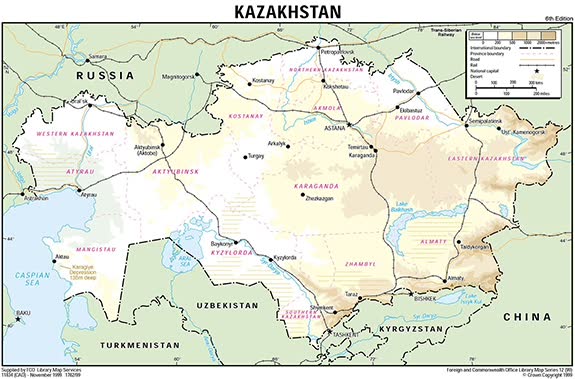Kazakhstan Railway
Kazakhstan's railway network is strategically linked to neighboring countries, facilitating the flow of goods and passengers across the region:

Russia: Kazakhstan shares a railway connection with Russia, benefiting from the same gauge, which is a legacy of the former Soviet Union railway system. This shared gauge allows for seamless rail travel and trade between the two countries.
China: The railway connection between Kazakhstan and China involves a break of gauge. Kazakhstan uses a gauge of 1,520 mm (4 feet, 11 and 27/32 inches), while China employs a gauge of 1,435 mm (4 feet, 8 and 1/2 inches). This break of gauge occurs at the border station of Druzhba in Kazakhstan and Alashankou in China. The railway connection links the Turkestan–Siberia Railway with the Northern Xinjiang Railway. It's worth noting that neither of these railways is electrified. Another railway link exists from Altynkol Railway Station near Khorgas to the Jinghe–Yining–Khorgos Railway, connecting to Ürümqi in China.
Kyrgyzstan: Kazakhstan shares a railway link with Kyrgyzstan that utilizes the same gauge, which is a continuation of the former Soviet Union railway system. This allows for efficient rail transportation between the two countries.
Uzbekistan: The railway connection between Kazakhstan and Uzbekistan also employs the same gauge, a legacy of the former Soviet Union railway system. This shared gauge eases rail transport and trade between the two nations.
Turkmenistan: Kazakhstan's railway network extends to Turkmenistan, and both countries utilize the same gauge. This railway link opened for freight transport in 2013.
Caspian Sea: Kazakhstan maintains a railhead with a gauge of 1,520 mm (4 feet, 11 and 27/32 inches) at the Caspian Sea, which is strategically significant for transportation and trade.

The transport development strategy in Kazakhstan until 2015 includes plans to construct 1,600 kilometers (990 miles) of new electrified railway lines and upgrade 2,700 kilometers (1,700 miles) of existing railway stations. These developments are crucial for enhancing the efficiency and capacity of the country's rail network.
Additionally, Kazakhstan has explored proposals to establish a standard gauge rail link from China to Europe. This project aims to further improve international connectivity and trade.
In 2007, there was a proposal to eliminate the break of gauge at Druzhba-Alashankou by converting the Kazakhstan main line to the European gauge, potentially streamlining rail transport between Kazakhstan and China.
Furthermore, a BOOT (Build, Own, Operate, Transfer) railway line from Zhetigen to Khorgos on the China border was proposed in 2008. This line would branch off from the existing railway near Shaquanzi and contribute to the development of rail infrastructure in the region.
Kazakhstan’s railway system, operated by Kazakhstan Temir Zholy (KTZ), is a cornerstone of the nation’s transportation infrastructure, facilitating both domestic mobility and international trade.
🚆 Overview of Kazakhstan Temir Zholy (KTZ)
Established in 1997, KTZ is Kazakhstan’s national railway company, headquartered in Astana. It oversees a vast network of approximately 21,000 kilometers of track, making it the 19th longest railway network globally. KTZ plays a pivotal role in connecting Kazakhstan internally and with neighboring countries, serving as a key transit route between China and Europe .
📈 Recent Developments and Performance
Financial Growth: In 2023, KTZ achieved a record net profit of 154 billion tenge (approximately $344 million), marking a fourfold increase from the previous year. This growth was driven by a 7% rise in freight turnover, reaching 270 billion ton-kilometers, and an 18% increase in transit traffic, exceeding 27 million tons .
Infrastructure Projects: KTZ is actively expanding its network, with projects like the construction of second tracks on the Dostyk–Moyynty section and a railway line bypassing Almaty station, aimed at enhancing capacity and efficiency .
🌍 Strategic Importance
Kazakhstan’s geographical position makes it a critical link in the Trans-Caspian International Transport Route, also known as the Middle Corridor, connecting China and Europe. The country is investing heavily in this corridor, with plans to build 1,300 kilometers of new railway lines by 2026, aiming to quintuple the corridor’s capacity to 500,000 containers annually .
⚙️ Modernization and Sustainability Efforts
Fleet Upgrades: KTZ has entered into a $405 million agreement with Wabtec to acquire Evolution Series ES44ACi locomotives, enhancing efficiency and reliability in freight operations .
Green Initiatives: A memorandum of understanding with Wabtec includes the acquisition of 150 FLXdrive battery-electric shunters and the conversion of mainline locomotives to run on liquefied natural gas (LNG), aiming to reduce greenhouse gas emissions and operating costs .
💻 Digital Transformation
KTZ is implementing a “Digital Railway” program, introducing digital route diagnostics, a traffic management center, and online services at multiple stations. These initiatives aim to enhance customer service, increase operational efficiency, and reduce costs .
Kazakhstan’s railway system, under KTZ’s stewardship, is undergoing significant transformation, positioning the country as a vital hub in Eurasian logistics and trade.